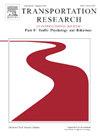Pedestrian crossing behavior and visual attention under flashing green countdown signals
IF 3.5
2区 工程技术
Q1 PSYCHOLOGY, APPLIED
Transportation Research Part F-Traffic Psychology and Behaviour
Pub Date : 2025-04-02
DOI:10.1016/j.trf.2025.03.021
引用次数: 0
Abstract
The interaction between signal-controlled intersection and pedestrian primarily relies on pedestrian traffic signals. With increasing pedestrian-related intersection accidents, it is imperative to investigate pedestrian behavior particularly under flashing green countdown signals. This experiment was conducted at a real-world signal-controlled intersection in Changsha City, China, where 30 university students (aged 20–28, with a balanced gender distribution) wore eye-tracking glasses and motion sensor while crossing the street. This study investigated the mechanism through which pedestrian countdown signals (PCS) affect pedestrian crossing behavior and visual attention under mobile phone distraction and time constraint, while exploring the differences in pedestrian behavior before and after the flashing green countdown signals. The results reveal that flashing green countdown signals prompted pedestrians to redirect their visual attention toward the PCS, enhancing the efficiency of visual information processing while significantly facilitating faster crossings. However, mobile phone distraction weakened these positive effects of PCS, reducing the likelihood of shifting visual attention toward the PCS and decreasing the relative speed change rate by 55%, while also increasing the rate of green phase crossing incompletion. Besides, this study indicates that pedestrians had a significantly reduced level of attention to the PCS under crossing time constraints, whereas attention to the zebra crossing area increased. Flashing green countdown signals had a stronger impact on pedestrians’ speed characteristics under limited crossing time, with crossing speed variation being 2.71 times more pronounced after PCS green light flashing, while the probability of visual attention shifts to the PCS decreased. These findings are significant for understanding the mechanisms by which the flashing green signal affects pedestrians and may provide a scientific basis for future intersection management policies and intelligent transportation infrastructure.
绿灯闪烁倒计时信号下行人过马路行为与视觉注意
信号控制交叉口与行人的交互主要依赖于行人交通信号。随着行人相关的十字路口交通事故的增多,研究行人的行为,特别是在绿灯倒计时信号闪烁的情况下,显得十分必要。本实验在中国长沙市一个真实的信号控制十字路口进行,30名大学生(年龄20-28岁,性别分布均衡)戴着眼球追踪眼镜和运动传感器过马路。本研究探讨了手机干扰和时间约束下行人倒计时信号对行人过马路行为和视觉注意的影响机制,同时探讨了绿色倒计时信号闪烁前后行人行为的差异。结果表明,闪烁的绿色倒计时信号促使行人将视觉注意力转向PCS,提高了视觉信息处理效率,同时显著促进了快速过马路。然而,手机分心削弱了PCS的这些积极作用,降低了视觉注意力向PCS转移的可能性,使相对速度变化率降低了55%,同时也增加了绿色相位穿越不完成率。此外,本研究还发现,行人在穿越时间限制下,对道路交通线的注意程度显著降低,而对斑马线区域的注意程度增加。绿灯倒计时信号闪烁对行人过马路时间限制下的速度特征影响更大,绿灯闪烁后行人过马路速度变化明显增加2.71倍,视觉注意力转移到路口的概率降低。这些发现对于理解绿灯闪烁对行人的影响机制具有重要意义,并可为未来的交叉口管理政策和智能交通基础设施提供科学依据。
本文章由计算机程序翻译,如有差异,请以英文原文为准。
求助全文
约1分钟内获得全文
求助全文
来源期刊
CiteScore
7.60
自引率
14.60%
发文量
239
审稿时长
71 days
期刊介绍:
Transportation Research Part F: Traffic Psychology and Behaviour focuses on the behavioural and psychological aspects of traffic and transport. The aim of the journal is to enhance theory development, improve the quality of empirical studies and to stimulate the application of research findings in practice. TRF provides a focus and a means of communication for the considerable amount of research activities that are now being carried out in this field. The journal provides a forum for transportation researchers, psychologists, ergonomists, engineers and policy-makers with an interest in traffic and transport psychology.

 求助内容:
求助内容: 应助结果提醒方式:
应助结果提醒方式:


